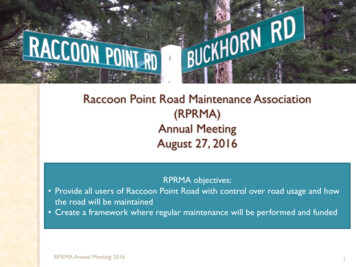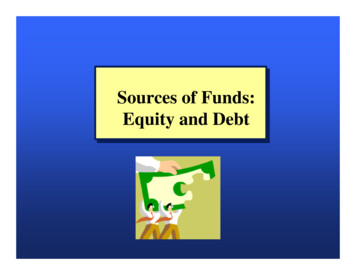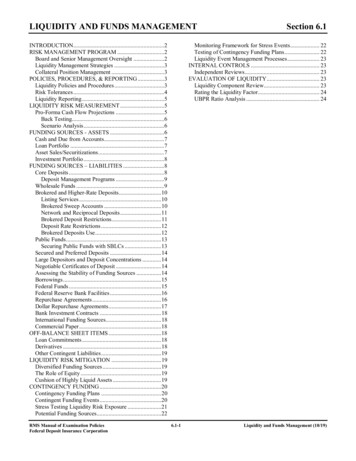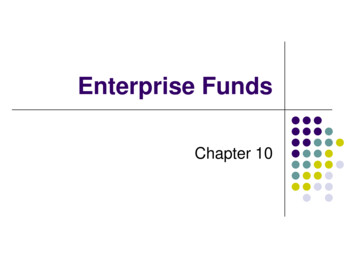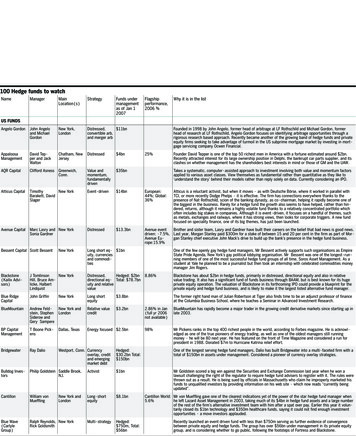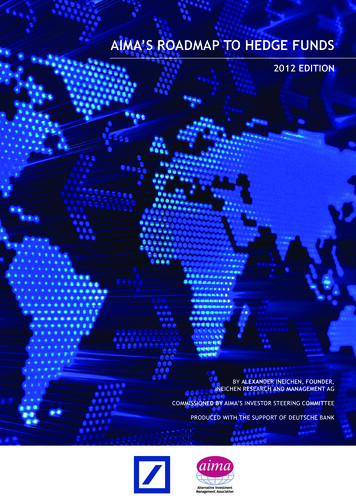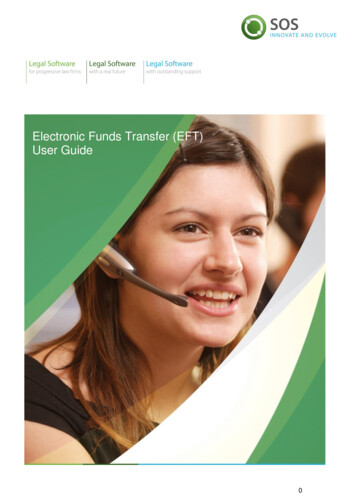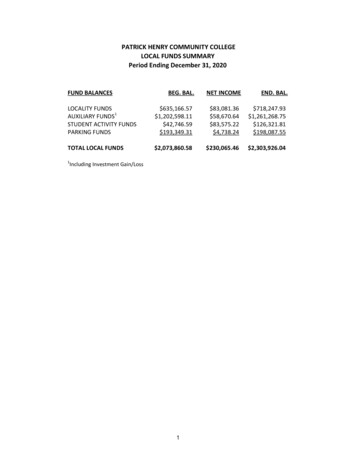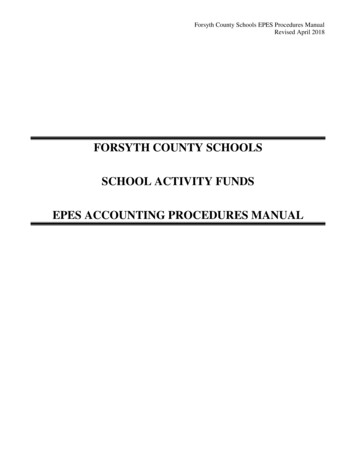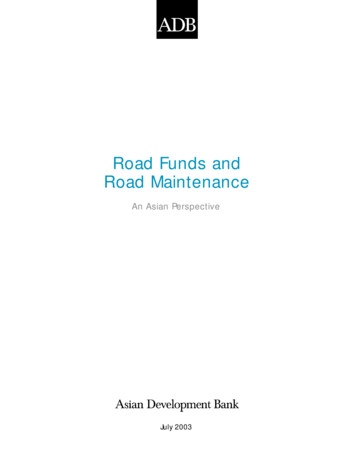
Transcription
ForewordRoad Funds andRoad MaintenanceAn Asian PerspectiveJuly 2003i
iiForeword Asian Development Bank 2003All rights reserved.The views expressed in this book are those of the authorsand do not necessarily reflect the views and policies of theAsian Development Bank (ADB), its Board of Governors,or the governments they represent.ADB does not guarantee the accuracy of the data includedin this publication and accepts no responsiblity for anyconsequences of their use.Use of the term “country” does not imply any judgmentby the authors or ADB as to the legal or others status ofany territorial entity.In this publication, refers to US dollar.Published and printed by the Asian Development BankP.O. Box 7890980 Manila, PhilippinesISBN 971-561-489-2Publication Stock No. 040403
ForewordiiiContentsI.II.III.IVIV.V.VI.VII.VIII.THE ISSUE . 1THE FACTS . 3FA1. Pavement Wear is Not the Problem . 32. The Struggle for Maintenance Money . 33. Road Maintenance—Good Business for the Road Agency? . 44. Road Maintenance—Good Business for Road Users . 45. Toll Roads Benefit Users: Implications for Road Agencies and Goverments . 56. What is Proper Maintenance? . 57. Computerized Pavement Management Systems . 68. Lenders as Part of the Problem . 79. Should Lenders Fund Maintenance? . 7THE LENDERS’ PERSPECTIVE . 9THE DEVELOPING MEMBER COUNTRIES’ PERSPECTIVE . 11THE CHALLENGES . 131. To Earmark or Not to Earmark? . 132. Which Roads to Fund. 133. How to Make Pavement Management Technology Locally Sustainable . 144. How to Involve Stakeholders . 145. How to Maintain National Commitment . 156. How to Preserve Lender Interest in the Road Sector. 157. Challenges to Lenders . 16A SOLUTION THAT WORKS . 1 7SOLUTIONTHAT1. Establish a Road Maintenance Fund . 172. Have the Finance Ministry Promote the Road Maintenance Fund . 183. Establish Locally Sustainable Pavement Management Systems . 194. Fund the Maintenance Backlog . 195. Acquire Lender Support . 206. Take Steps Toward Sustainable Funding of Road Maintenance . 20AN ALTERNATIVE SOLUTION . 2 3ALTERNATERNATIVESOLUTION1. Self-Reliance . 232. Transformation Forum . 233. An Agenda for Change . 244. Development Agencies as Facilitators, not Drivers, of Change . 245. Supporting the Process of Change . 246. Keeping Changes on Track . 26AN APPROA CH TO COMBATING MAINTENANCE NEGLECT . 2 7APPROACOMBATING
ivForewordAPPENDIXES1. Road Maintenance Funds: Current Good Practice . 292. An Alternative Route to Sustainable Funding . 373. Review of Selected Road Funds and Road Fund Initiatives . 454. Summary Report of the Regional Workshop on Funding for Road Maintenance . 63Annex A. Workshop Program . 75Annex B. List of Participants . 77Annex C. Groupings for the Workshop Sessions . 85Annex D. Workshop Sessions, Results, and Recommendations . 915. Bibliography . 101
ForewordvGlossaryADBbenefit-cost ratioCRFdiscount rateDMCearmarkingEIRRfinance ministryfiscal flexibilityGTZHDM3HDM4IMFinformal incomelendersNGOpavement management systemQARETARMFRMIroad maintenanceroad management systemroad tariffTAAsian Development Bankratio of discounted benefits to discounted costsconsolidated revenue fund—central revenue account into which all taxes and feesdue to the government are paidpercentage annual rate at which the value of future benefits and costs are reduced tocompare with present-day costs and benefitsdeveloping member country (of ADB)process of reserving revenues, or portions of revenues, from certain taxes for a givenuse (such as road maintenance)economic internal rate of return: the discount rate at which the sum of discountedcosts and benefits equals zerogeneric term covering various agencies found in DMCs, variously known as theMinistry of Finance, Department of Budget, Ministry of Economy, and alsoplanning agencies that share responsibility for economic efficiencyfreedom to allocate, at will, expenditure of funds in the national budgetDeutsche Gesellschaft für Technische Zusammenarbeit GmbH (German Agencyfor Technical Cooperation)Highway Design and Maintenance Standard ModelHighway Development and Management SystemInternational Monetary Fundincome derived from the informal sector of the economy (nonregistered or untaxedeconomic activities)generic term for multilateral agencies, like ADB, and bilateral agencies, like GTZ(q.v.) that provide loans to developing countriesnongovernment organizationsystem by which pavement condition is tracked and maintenance needs identifiedquality assurance: a system by which quality is assured by auditing processes, ratherthan checking each outputregional technical assistanceRoad Maintenance FundRoad Maintenance Initiative (of the World Bank and bilateral donor agencies, inSub-Saharan Africa)all activities needed to keep a road operating indefinitely—routine maintenance,periodic maintenance, and rehabilitationsystem by which the condition of pavements, bridges, and road furniture is trackedand maintenance needs identifieda set of fees and charges that act as prices charged for road usetechnical assistance:resources, funded either by a loan or grant, for projectpreparation, advisory and operational purposes, and regional activities
viForeword
ForewordviiForewordIt is widely accepted that roads play an important role in development, and help reduce poverty. To realize theirpotential contribution, however, roads need to be properly maintained. In many of the Asian Development Bank’s(ADB’s) developing member countries (DMCs), the standard of road maintenance is poor. Often the main reasongiven for poor road condition is that funds for road maintenance are inadequate.This report presents the findings of a regional technical assistance (TA) 5871: Road Funds Strategy, which wascarried out between April 2000 and March 2001 to examine the problem of road funding and propose solutions.Under the TA, road funding experiences worldwide were reviewed (Appendix 3) together with other relevantsource materials, a bibliography of which is appended (Appendix 5). But much of the existing body of knowledge onroad funds relates to either African or Latin American countries. Therefore, the question arises as to how much of thisexperience is relevant to Asian countries. Of particular concern were issues relating to Asian perceptions of the need forroad maintenance and the funding and administration required to address that need. To address this gap, detailed factfinding trips were made to Kyrgyz Republic, Lao People’s Democratic Republic, Pakistan, Philippines, Uzbekistan,and Viet Nam to discuss the perceptions and experiences of road funds with government officials and road users. Fromthese initial meetings, issues and perceptions emerged, which were used as the basis for the Regional Workshop onFunding for Road Maintenance. At this Workshop, held at ADB in Manila on 6–7 March 2001, more than 60 participants representing 20 Asian countries, the international development community, and other interested parties discussedthe Asian experience with road funds. A report on this Workshop can be found in Appendix 4. The results of thisWorkshop were used to refine the proposed approach to combat maintenance neglect presented in this report.For much of the project, Marcelo Minc was the ADB project officer supervising and guiding work. The projectwas finalized under Paul Vallely. The consultants engaged to undertake the work were Ronald Allan and Olga Caday.The contribution of Stephen Vincent to Chapter VII is gratefully acknowledged.
The Issue1I. THE ISSUEIn the developing world, roads are deteriorating forwant of maintenance. Roads are being lost. The AsianDevelopment Bank (ADB) and other agencies lending money for roads are concerned about this. Inadequatemaintenance is the cause of the problem. Maintenanceincludes all activities needed to keep a country’s road network operating indefinitely: routine maintenance (restoring drainage, fillingpotholes and cracks, maintaining edges); periodic maintenance (resealing, about every5 years, to rejuvenate the surface); and rehabilitation (overlaying, about every 15 years,to restore smoothness and durability).A road network is sustainable when it is in satisfactory condition1 and does not, as a whole, deteriorate overtime. Individual roads do not remain static: paved roadsgo through a cycle of accumulating roughness, despiteroutine and periodic maintenance, until they are restoredto their original smoothness by rehabilitation. Since a network is made up of roads that individually are at all pointsin this maintenance cycle, the condition of the network asa whole does not change year by year. A sustainable roadnetwork is, therefore, one that is maintained.Inadequate maintenance is attributable to any of thefollowing reasons: Money is not allocated (in sufficient amounts). Money is allocated but not spent. Money is not spent efficiently. Money is not spent effectively.Addressing only the first cause—allocating moremoney—will not be enough to solve the road maintenanceproblem; it has not sufficed in the past. This study recognizes the importance of all four causes and addresses them.Almost all ADB’s developing member countries(DMCs) fail to maintain roads properly. In principle, the1“Satisfactory” in terms of serving the amount and type of traffic using the road.problem should not be hard to fix. All that is needed is asystematic and rational set of rules and tools to identifyand plan maintenance tasks, a trained workforce withequipment to carry out the work, and the money to pay forit. Experience reveals, however, that solving the road maintenance problem is considerably more resistant to solution than it appears. Many countries have tried to reformroad maintenance but have failed—or reforms havelapsed—after a short period of improved performance.ADB, at times in cooperation with the World Bank,has been working with its DMCs, some of which havegone down the path toward reform but have generally cometo a halt just before the final step: implementing change.The arguments for reform are compelling and the benefits are great, yet there is a very strong reluctance tochange. How to overcome this reluctance is the challengefaced by this study.This study did not set out to reinvent good practice.Rather, it builds on existing knowledge and looks at theimplementation problems that have prevented good practice from being given a chance. Over the last 15 years, ahandful of developing countries, mainly in Africa and theCaribbean, have reformed their road maintenance funding with strong encouragement and support from theWorld Bank and German Agency for TechnicalCooperation.2 The experience gained has identified thestrengths and weaknesses of the main options for reform.There is now a body of knowledge that is considered bymany to be good practice.The following sections of this study first describe theproblem in greater detail, together with the challenges involved in providing adequate road maintenance, then setout the lenders’ and the DMCs’ views of the situation.Two sections follow that propose solutions that can meetthe challenges of road maintenance. The final section2Deutsche Gesellschaft für Technische Zusammenarbeit GmbH.
2Road Funds and Road Maintenancepresents a recommended approach for ADB and otherdevelopment agencies. Several appendixes support the maintext, notably one on good practice for road maintenancereform, and another containing observations and recommendations from participants in the March 2001 Regional Workshop on Funding for Road Maintenance.
The Facts3II. THE FACTS1. Pavement Wear is Not theProblemOver the past 2 decades, much has been saidand written about loss of huge investments inroads in the developing world. 3 Roads arebeing lost (or at least pavements are being lost) becausethey deteriorate into muddy, or dusty, or potholed dirt andgravel; slivers of asphalt among the potholes betray manyroads that were once sealed, i.e., water- and wear-proofedwith asphaltic concrete or portland cement concrete. Pavements are supposed to wear out: a bitumen pavement isdesigned to accumulate fatigue and to progressively loseits smoothness. Rehabilitation restores it to its initial condition. Then the cycle repeats itself, so pavement wear offitself is not the problem. But pavements should not wearout prematurely, nor should they be left so long that rehabilitation is no longer any use and they have to be reconstructed. It is the failure to maintain the roads that hascost some countries very large sums.Maintenance includes all activities needed to keep aroad operating indefinitely: routine maintenance (restoring drainage,filling potholes and cracks, maintaining edges); periodic maintenance (resealing, about every5 years, to rejuvenate the surface); and rehabilitation (overlaying, about every 15 years,to restore smoothness and durability).In feasibility studies assessing the economic value ofsealing pavements, it is assumed that proper routine andperiodic maintenance will prevent premature failure, thatpavements will be rehabilitated when they get too rough,and that they will not be left to deteriorate further until3Harral, Clell, and A. Faiz. 1988. Road Deterioration in Developing Countries—Causesand Remedies. Washington, D.C.: World Bank.they need reconstruction. These assumptions may be false,however. Sealing a pavement may be uneconomic: if sealedpavements are not properly maintained, they may be moreof a burden than a benefit to the economy.2. The Struggle forMaintenance MoneyProviding funds for road maintenance is a struggle,for many reasons: Pavements need preventive maintenance. Money isbest spent on maintaining pavements before theneed is apparent: the right time to reseal is beforedeterioration is obvious to a nonexpert. As bitumen oxidizes, pavements become brittle and startto crack. At the early stage of cracking, a resealwill rejuvenate the surface and restore its elasticity. Once cracks are obvious, a reseal will nolonger work: the cracks are too big and will comethrough the new seal, reappearing on the surface.Cracks let in water. Water softens the road baseand causes the road to break up. Clearly, it is bestto reseal early. But it is difficult to secure fundingto repair pavements that do not (yet) look broken. Capital bias. Even when the road budget isadequate for proper maintenance, maintenancecan still be inadequate, because of capital bias.– Politicians want to build new roads. Capitalexpenditure and ribbon cutting win morevotes than keeping roads in good condition.In fact, letting pavements collapse winsvotes—when they are rebuilt. The publicmistakenly thinks the remedy for bad roadsis renewal, not maintenance.
4Road Funds and Road MaintenanceTo engineers, maintenance is not glamorous.They are trained to design and to construct,and do not consider maintenance their mission in life.– “Rent seeking” favors capital bias. In countries where corruption is endemic, capitalprojects provide opportunities to divert largesums of money. Rehabilitation is classified as capital spending. Eventhough rehabilitation is part of road maintenance,accounting conventions treat it as capital spending, because it is costly and has a long life. Rehabilitation projects then join the list of candidatesvying for inclusion in the capital budget orinvestment program. Rehabilitation should havepriority, but does not.4 Equity and fairness: unmaintainable roads. Sometimes spending money to maintain, e.g., reseal,an access road to a village seems unfair, when aneighboring village still has no all-weather accessat all. It may even be government policy for allvillages to be given all-weather access. But building more roads is foolish if it means letting thosealready built deteriorate due to lack of maintenance. Good care needs to be taken of what hasbeen built. New roads should be added on
RMF Road Maintenance Fund RMI Road Maintenance Initiative (of the World Bank and bilateral donor agencies, in Sub-Saharan Africa) road maintenance all activities needed to keep a road operating indefinitely—routine maintenance,

